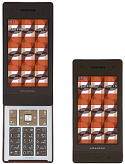LiMo adds another carrier, nine new phones
Aug 11, 2009 — by Eric Brown — from the LinuxDevices Archive — 1 views[Updated: 6:15AM] — The LiMo Foundation mobile Linux consortium announced two new members, as well as nine new LiMo-compatible phones from NEC and Panasonic, aimed at NTT DoCoMo's 3G network in Japan. The new members include the second-ranked carrier in Japan, KDDI Corp., as well as haptics touchscreen technology firm Immersion Corp.
With this latest release, the total number of LiMo-compliant handsets rises to 42. LiMo counts some of the largest wireless carriers in the world among its membership, representing about one billion mobile subscribers, says the LiMo Foundation.
The LiMo spec, which covers both feature phone and smartphone segments, offers common Linux middleware and related specifications. For developers, this eases the process of writing applications that support multiple phones from different carriers. Carriers, meanwhile, enjoy more freedom compared to Android and other platforms in branding application stacks and UI elements atop the common spec.
The announcement was tipped two weeks ago when executive director Morgan Gillis revealed in an interview with LinuxDevices that more LiMo-compliant phones would be announced soon. At the time, Gillis said the mid-August announcement would be followed by more significant handset and membership announcements in October, as phones adhering to the second-generation LiMo R2 spec reach market (see below for more on R2).
KDDI and Immersion join LiMo
With approximately 30 million subscribers, KDDI is Japan's second-largest wireless operator, behind leading carrier NTT DoCoMo and ahead of number-three Softbank, says LiMo. Together, the three LiMo members are said to represent a market of more than 100 million Japanese subscribers.
 |
Last year, KDDI announced a Linux-based IP set-top box (STB) called the Au Box (pictured) that converts and transmits TV and Web content to the Japanese carrier's cell phones. Based on Motorola's VIP1830 hardware platform, the Au Box also plays back music stored on the phones, and offers CD ripping, says KDDI.
The other new member, San Jose, Calif.-based Immersion Corp., announced that it is offering its "TouchSense" haptic technology API without charge to LiMo members. Its haptic player, which offers touch-related effects, is available to members under separate license.
TouchSense offers touchscreen confirmation feedback for mobile phones, consumer electronics, game devices, and manufacturing interfaces. Immersion typically partners with manufacturers of actuators and amplifier integrated circuits, providing integration services for developing small-footprint, low-power, high definition haptic effects. The technology is used by companies including LF, Samsung, and Nokia in their handsets.
Touchscreen haptics are emerging as a key driver in the mobile marketplace, notes LiMo. The group cites an NPD Group study projecting that touchscreen revenues will jump to $9 billion by 2015.
 |
Nine new LiMo phones
As with last February's announcements of nine new LiMo phones, the latest handsets are upgrades to NEC and Panasonic phones designed according to NTT DoCoMo brand specifications, including Prime, Smart, and Style. Recent models have included the Docomo Smart series N-04A, pictured at right. The new phones are said by LiMo to offer high-megapixel cameras, rich media capabilities, and upgraded connectivity support compared to earlier models.
New LiMo-compliant phones from NEC are said to include:
- Docomo Prime series N-06A
- Docomo Prime series N-07A
- Docomo Style series N-08A
- Docomo Smart series N-09A
The new Panasonic LiMo phones are said to include:
- Docomo Style series P-06A
- Docomo Prime series P-07A
- Docomo Style series P-08A
- Docomo Smart series P-09A
- Docomo Style series P-10A
LiMo Foundation did not offer more details on the new phones at presstime, but previous LiMo/DoCoMo phones have not brought quite the same level of sophistication as modern smartphone platforms like the iPhone, the various HTC-made Android phones, or the Palm Pre.
In our recent interview, LiMo's Morgan Gillis, said that some of the phones announced in August would offer some features of the new R2 spec, which defines a more robust smartphone. Fully compliant R2 phones won't be announced until October, he added.
The next round should include a number of new manufacturers aside from NEC, Panasonic, and Motorola, which shipped several LiMo phones last year before announcing a switch to Android for its future smartphones. LiMo is also expected to expand from its NTT DoCoMo base to be represented by carriers such as Orange, SK Telecom, Telefonica, Verizon Wireless, and Vodafone, all of which announced they would ship LiMo phones this year.
Gearing up for R2
In June, LiMo Foundation announced the completion of its second-generation R2 specification for the LiMo Platform. APIs corresponding to the R2 platform will be released publicly in the early fall, and handsets based on the platform will begin to appear by the fourth quarter, said the group.
The R2 spec offers new location-based services (LBS), multimedia, personal information management (PIM), and security features for LiMo handsets, LiMo Foundation says. More significantly, R2 also includes support for the BONDI web-app interoperability spec developed by the Open Mobile Terminal Project (OMTP), an industry standards group backed by mobile operators. BONDI is said to make it easier to develop UI widgets that work across all compliant platforms.
Stated Gillis as part of the announcements, "Garnering the support of two market leaders with long-standing legacies of disruptive innovation is a testament to LiMo's pre-eminent position in the mobile ecosystem."
Stated Kiyohito Nagata of NTT DoCoMo, and chairperson of LiMo Foundation, "The successful launch of the latest LiMo handsets further establishes LiMo Platform as a leading device platform within today's rapidly evolving mobile ecosystem."
Availability
The nine new LiMo-ready NTT DoCoMo phones from NEC and Panasonic appear to be shipping this month in Japan. More information on LiMo Foundation may be found here, and more on NTT DoCoMo should be here.
This article was originally published on LinuxDevices.com and has been donated to the open source community by QuinStreet Inc. Please visit LinuxToday.com for up-to-date news and articles about Linux and open source.